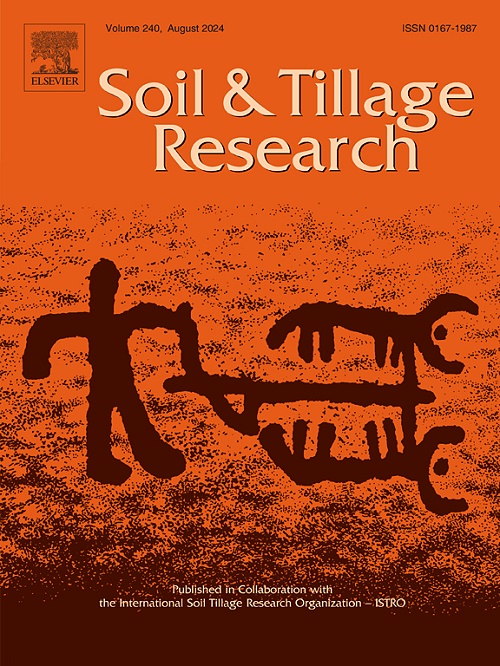Enhancing soil property predictions using spectral fusion: Comparisons between outer product analysis and vector concatenation and among modeling algorithms
IF 6.1
1区 农林科学
Q1 SOIL SCIENCE
引用次数: 0
Abstract
Multiple approaches have been employed to improve predictions of soil properties using vis-NIR-SWIR and mid-IR spectra, including techniques for extracting/enhancing spectral features and various types of regression models. However, only a few studies have conducted statistical comparative analyses to evaluate the impact of spectral fusions and different algorithms in enhancing prediction performances. So, the aim of this study was to compare the predictions of several soil properties (32 in total) using individual (vis-NIR-SWIR and mid-IR) and fused spectra and four different modeling algorithms. We used a spectral database comprising 1259 soil samples, collected in four Brazilian states, and containing chemical, physical, and mineralogical attributes. Outer Product Analysis (OPA) and Vector Concatenation, called here Side-by-Side (SbS), were used as spectral fusion strategies. Additionally, we also tested the following regression models: Support Vector Machine (with linear and radial Kernel functions), Partial Least Squares Regression, and Boosted Regression Trees. Our results showed the effectiveness of both fusion strategies in enhancing the spectroscopic modeling of soil properties compared to the individual ranges. Fused spectra significantly improved the modeling of most soil properties by utilizing all spectral information in distinct ways. Comparing these two strategies, OPA produced better results (models with R2 ≥ 0.50) for 70 % of all soil properties, while this proportion was 48 % for SbS. Support Vector Machine with linear kernel trick performed the best significant modeling results for 78 % of all soil properties with R2 ≥ 0.50. Thereby, our results confirm the usefulness of the spectral fusion as an effective technique to improve the spectroscopic prediction of soil properties important for soil survey, classification, mapping, and management.
利用光谱融合增强土壤属性预测:外部产品分析和向量拼接之间的比较以及建模算法之间的比较
采用多种方法来改进使用可见光- nir - swir和中红外光谱对土壤性质的预测,包括提取/增强光谱特征的技术和各种类型的回归模型。然而,只有少数研究进行了统计比较分析,以评估光谱融合和不同算法对提高预测性能的影响。因此,本研究的目的是比较使用单个(vis-NIR-SWIR和mid-IR)和融合光谱以及四种不同建模算法对几种土壤特性(总共32种)的预测。我们使用了一个包含1259个土壤样本的光谱数据库,这些样本收集于巴西的四个州,包含化学、物理和矿物学属性。采用外产物分析(OPA)和矢量拼接(SbS)作为光谱融合策略。此外,我们还测试了以下回归模型:支持向量机(具有线性和径向核函数),偏最小二乘回归和增强回归树。我们的研究结果表明,与单个范围相比,两种融合策略在增强土壤特性的光谱建模方面都是有效的。融合光谱通过以不同的方式利用所有光谱信息,显著改善了大多数土壤特性的建模。比较这两种策略,OPA对70% %的所有土壤性质产生了更好的结果(R2≥0.50的模型),而SbS的这一比例为48% %。采用线性核技巧的支持向量机对78 %的土壤性质进行了最佳的显著性建模,R2≥ 0.50。因此,我们的研究结果证实了光谱融合是一种有效的技术,可以提高土壤性质的光谱预测,对土壤调查、分类、制图和管理具有重要意义。
本文章由计算机程序翻译,如有差异,请以英文原文为准。
求助全文
约1分钟内获得全文
求助全文
来源期刊

Soil & Tillage Research
农林科学-土壤科学
CiteScore
13.00
自引率
6.20%
发文量
266
审稿时长
5 months
期刊介绍:
Soil & Tillage Research examines the physical, chemical and biological changes in the soil caused by tillage and field traffic. Manuscripts will be considered on aspects of soil science, physics, technology, mechanization and applied engineering for a sustainable balance among productivity, environmental quality and profitability. The following are examples of suitable topics within the scope of the journal of Soil and Tillage Research:
The agricultural and biosystems engineering associated with tillage (including no-tillage, reduced-tillage and direct drilling), irrigation and drainage, crops and crop rotations, fertilization, rehabilitation of mine spoils and processes used to modify soils. Soil change effects on establishment and yield of crops, growth of plants and roots, structure and erosion of soil, cycling of carbon and nutrients, greenhouse gas emissions, leaching, runoff and other processes that affect environmental quality. Characterization or modeling of tillage and field traffic responses, soil, climate, or topographic effects, soil deformation processes, tillage tools, traction devices, energy requirements, economics, surface and subsurface water quality effects, tillage effects on weed, pest and disease control, and their interactions.
 求助内容:
求助内容: 应助结果提醒方式:
应助结果提醒方式:


